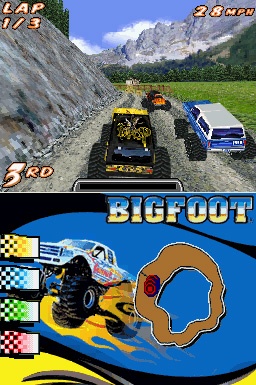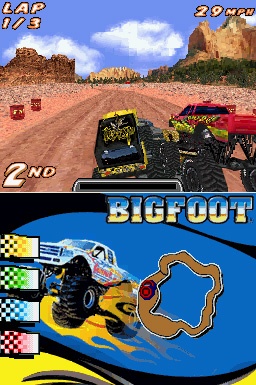When Bob Chandler started work on the first Bigfoot monster truck in the mid '70s, he surely had no idea that his creation would spawn a popular new motorsport. He also couldn't have guessed that Bigfoot would be headlining a handheld racing game more than 30 years later. That's just as well, because if he'd known about Bigfoot Collision Course for the Nintendo DS back then, he might have abandoned the whole monster-truck idea to save us from it. Bigfoot Collision Course isn't just a racing game that lacks any real sense of speed--it's also a racing game with less than two hours' worth of uninspired content and which lacks any multiplayer component whatsoever. In short, it's almost impossible to recommend.

Gameplay options are limited to practice sessions, quick races, and a bare-bones Career mode. Practice sessions afford you an opportunity to drive around tracks without any opposition, but none of the course designs are even close to being challenging enough to warrant you learning your way around them. The Quick Race mode is literally pointless because the only difference between it and the Career mode is that you can't unlock any additional trucks or tracks in quick races. At the outset of your career, you have access to only two monster trucks, there are only four tracks to race, and you can compete only at an amateur level. Eight easy three-lap races later, you're done with the amateurs and can race in "Pro Stock" competitions. Winning races doesn't get any harder when you step up to the Pro Stock class, but the trucks are faster and some of the courses are a little longer. After winning another eight three-lap races, you get to go head-to-head against a truck named Bigwheels on the only remotely interesting course in the game, and after winning that, there's nothing else to do unless you feel compelled to go back and beat your best times.
Bigfoot Collision Course's only distinguishing feature is that you're encouraged to drive through obstacles rather than around them. Tracks are littered with oil drums, crushed cars, caravans, and even wooden shacks that you can crash through to replenish a power-boost meter that, when full, can be used to significantly increase your speed for a few seconds. There are also a lot of tree stumps, logs, and rocks on some of the tracks that, for the most part, you can just race over the top of. Occasionally, though, and seemingly at random these innocuous objects will bring your truck to a grinding halt and, if you're really unlucky, you might have to reverse and go around them because you no longer have the momentum to get over them.
There are 13 different monster trucks in Bigfoot Collision Course, with varying ratings in just two areas: speed and handling. Early on, your choices are limited to either fast trucks with appalling handling or slower trucks that are much easier to get around corners. You're generally better off with the latter, but you're in for a frustrating ride either way. Every truck that you unlock is better than the rest that are available, so you rarely use the same one for more than one or two races. Toward the end of the amateur and pro seasons, you gain access to trucks that can both drive fast and turn around corners with a minimum effort. Unsurprisingly, these are the licensed Bigfoot ("First Bigfoot" and "Bigfoot") and Snake Bite ("Snake Bite 1" and "Snake Bite 2") trucks, the latter of which, in real life, are actually Bigfoot trucks competing with different paint jobs.

Different track surfaces, which include sand, mud, and ice, have no effect on vehicle handling at all, and that holds true if you stray off of the track onto grass or snow. Walls that are either invisible or plastered with forest textures prevent you from straying too far, but they're overly punishing because contact with them invariably results in your truck getting stuck in them until you either reverse back out or manage to turn out of them while stuttering forward. Oddly, your truck stutters in a similar way for no discernable reason on the requisite ice track; the effect is that you appear to be making small jumps forward in much the same way that opponents with slow Internet connections do in some online racing games.
Stuttering aside, Bigfoot Collision Course runs smoothly, though that's no great feat given the simplistic visuals and lack of speed. Unfortunately, the quality of the audio is entirely in keeping with the quality of every other aspect of the game. Whereas you might expect a throaty roar of engines, you get what sounds like a troublesome lawnmower, and though all of the locations in the game could conceivably be in the United States, the soundtrack seems designed to give the impression that you're touring the world or something. Rock, tribal, and Indian restaurant are among the music genres poorly represented here, but given the quality of the engine noise, the optional music is the lesser of two evils.
Even with its budget price tag, Bigfoot Collision Course is a game that you should steer clear of. There's barely two hours of content here even if you manage to lose a few races along the way, and the very idea of a racing game with no multiplayer at all is laughable. Spend your money on a VHS copy of the Bigfoot and the Muscle Machines cartoon series before you spend it on this.